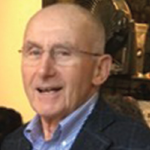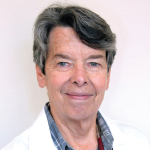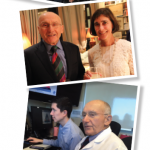
Mascha Tace / shutterstock.com
For many uninsured and underinsured patients in Yuba City, Calif., seeing a rheumatologist used to mean taking a day off from work and driving 108 miles, roundtrip, to the University of California Davis Medical Center.
That changed this year when patients were offered the option of having a telemedicine consultation with a rheumatologist as part a pilot project between the MAVEN (Medical Alumni Volunteer Expert Network) Project and Ampla Health, a nonprofit network of community-based Federally Qualified Health Centers (FQHCs).1
Launched in 2014 by Laurie Green, MD, a San Francisco obstetrician-gynecologist, MAVEN links retired rheumatologists and other specialists to clinics and organizations in underserved communities through telehealth technology.
“Today, one in 15 people in this country receive medical care from local Community Health Centers (CHCs) that specifically serve uninsured, low-income or geographically distanced patients,” Dr. Green says. “Many of these patients receive basic care at CHCs, but specialty medical services continue to be beyond their reach.”
Although the entire country is currently facing a physician shortage, Dr. Green says the lack of qualified physician specialists is expected to become worse in the years to come and to hit rural areas the hardest. A 2016 physician workforce report released last April by the Association of American Medical Colleges (AAMC) found the U.S. will experience a significant physician shortage over the next decade.2 By 2025, the study estimates a shortfall of between 14,900 and 35,600 primary care physicians and a shortfall of between 37,400 and 60,300 physician specialists.
According to the ACR’s 2015 Workforce Study, the demand for rheumatology services is expected to increase by about 27% by the year 2020 and 45% through the year 2025.3 With the soaring patient demand, current and projected figures indicate the rheumatology workforce will be insufficient to meet that demand. The number of rheumatologists available to meet patient demand will likely fall short by about 3,500 full-time equivalent rheumatologists.
Knowing there had to be a better way to provide medical care to vulnerable patient populations, MAVEN hopes to fill in gaps caused by the nation’s physician shortage. Currently operating in California, Massachusetts and Florida, and with plans to expand to other states, MAVEN partners with community health clinics to provide guidance and support, as well as physician volunteers that can work with clinic staff to offer specialty consults to patients.
When MAVEN first launched, Dr. Green and her staff worked to fill the gaps with the millions of patients who enrolled in the Affordable Care Act (ACA). Since the 2016 election, they are monitoring how proposed changes to the ACA may impact those on Medicaid or who receive care at community health clinics.
“There are a lot of patients who are uninsured or underinsured and as people age, their healthcare needs typically increase,” Dr. Green says.
Using Telemedicine to Evaluate Rheumatology Patients
Gerson Bernhard, MD, FACP, MACR, a clinical professor of Medicine at the University of California
San Francisco (UCSF), is semi-retired and has volunteered with MAVEN for the last year and a half. He was one of three rheumatologists who worked on the Ampla Health pilot project.
“Each of us would spend an afternoon seeing patients through telehealth consults,” says Dr. Bernhard. “A nurse, physician’s assistant or physician would sit with patients in an exam room at the community health center, while my rheumatology colleagues or I would talk with the patient and assess their rheumatic condition via camera.”

Dr. Bernhard
Dr. Bernhard says patient diagnoses in the pilot project ran the gamut and included arthritis, fibromyalgia, psoriatic arthritis and gout.
“For patients who require further evaluation, I arrange to have them visit our rheumatology clinic in San Francisco,” Dr. Bernhard says. “Once their condition is stable, they can continue to receive follow-up care at their local community health clinic.”
In addition to doing telehealth consults with patients, Dr. Bernhard says MAVEN volunteers also work to educate primary care physicians, nurse practitioners and physician assistants who serve as the first line of evaluation for patients.
“I think the education component is one of the most important things we can share with our colleagues in community health centers,” Dr. Bernhard says. “It assists them in deciding which patients need to receive more specialty management care.”

Dr. Upchurch
Katherine Upchurch, MD, a rheumatologist at UMass Memorial Medical Center in Worcester, Mass., was one of MAVEN’s first volunteers on the East Coast. Currently on medical leave from her practice, she volunteers with MAVEN five hours each month.
“I’ve done one-on-one specialty telehealth consults with patients and their nurse practitioners in community health clinics,” says Dr. Upchurch. “Access is definitely a barrier for many of the patients. It’s hard to see a specialist when they live in towns outside big cities, have mobility issues, no transportation and often don’t speak English fluently.”
Dr. Upchurch says these obstacles can result in insufficient management of a patient’s rheumatic disease, whereas telehealth has been shown to improve patient outcomes.
Research published in the April 2016 issue of BMC Musculoskeletal Disorders compared patients receiving intensive treatment for rheumatoid arthritis via telemonitoring with patients receiving conventional medical care. The results showed the telemedicine group demonstrated better outcomes in several areas including a higher percentage achieving remission at the one-year mark, a shorter median time to remission (20 weeks as opposed to 36), greater improvements in functional impairment, radiological damage progression and comprehensive disease control.4
As telehealth continues to evolve, ways to improve the tele-rheumatology experience for both patients and MAVEN’s volunteer rheumatologists exist, says Dr. Upchurch.
“We plan on doing some webinars with the medical staff at community clinics and to train community clinic practitioners on how to perform joint exams on patients to complement the volunteer physician’s video consult,” Dr. Upchurch says.
Frederick Anderson, MD, assistant professor and medical director for the Department of Humanities, Health & Society at Florida International University’s Herbert Wertheim College of Medicine in University Park, Fla., just began partnering with MAVEN on a rheumatology telehealth project. Although rheumatologists do practice in South Florida, Dr. Anderson notes they are generally not accessible to uninsured patients.
“There’s a long wait through the local public hospital for various specialists, which is not uncommon nationwide for uninsured patients,” Dr. Anderson says. “Working with MAVEN allows us to access specialty expertise for our uninsured and underserved patients in a faster manner.”
The partnership also allows clinics, such as Dr. Anderson’s, that care for patients with complex rheumatologic conditions to get specialty consults and feedback on cases that may appear hard to treat.
“We are presently focusing on advisory consults via telemedicine with specialists that deal strictly with de-identified patient information,” Dr. Anderson says. “I’ve spoken with a MAVEN rheumatologist regarding patient cases involving conditions such as suspected lupus with elevated ANA levels and questions regarding next steps for diagnosis, fibromyalgia management questions, as well as general questions regarding appropriate interpretation of elevated antibody levels like ANA or RF.”
Volunteering & a Social Outlet
The idea for MAVEN was first conceived while Dr. Green was serving as president of the Harvard Medical School Alumni Association. As she talked with various alumni, she kept hearing how many doctors who were nearing retirement age wanted to stay active in the medical world, but had no place to volunteer. Today, MAVEN attracts a wide range of physicians at various points in their careers.
“Our physician volunteers include retirees, those who are semi-retired or taking a break from their careers, and even industry and private practice doctors who want to lend their expertise to vulnerable patient populations,” says Jill Einstein, MD, an internist and director of physician engagement for the MAVEN Project. “We look for physicians who can commit to volunteering a minimum of four hours a month for at least six months.”
Dr. Green says MAVEN is unique in that it offers a community of volunteer physicians with altruistic motives who may not want to travel to remote regions with such organizations as Doctors Without Borders, but who do want to contribute their expertise to the greater good for a few hours a week.
“We are building a national network of physician specialists in rheumatology, hematology, cardiology, endocrinology and gastroenterology, who can remotely provide medical services to underserved populations,” Dr. Green says.
In addition to providing specialist care to community health clinics, Dr. Green says MAVEN also provides a volunteer and social outlet for rheumatologists who want to continue providing patient care without handling the business side of medicine.
“Doctors work in large student cohorts as they progress through medical school and then work with colleagues throughout their career,” Dr. Green says. “Suddenly in retirement, they become isolated and no longer have that interaction with others who share their medical mindset.”
Dr. Green adds that the staff of MAVEN work hard to make the volunteer experience a seamless one for physicians.
“We facilitate onboarding, cover malpractice insurance for MAVEN-related activities and provide our volunteer physicians with access to HIPAA-secure telehealth technology,” Dr. Green says.
For retired physicians, including Dr. Bernhard, MAVEN provides the opportunity to share their expertise and to help patients who have difficulty accessing rheumatology services.
“MAVEN gives retired physicians the chance to stay involved,” Dr. Bernhard says. “While our country is experiencing a physician shortage, we’re also seeing an increase in the number of people with rheumatic diseases, in part because of the aging baby boomer generation.”
Dr. Einstein notes that MAVEN offers their volunteer physicians flexible hours and the ability to work from their own home or office.
“We’re also creating a physician community where our volunteers can connect with their MAVEN colleagues either online or in person,” Dr. Einstein says. “We recently had a social event that brought together many of our West Coast physician volunteers, and we plan to host similar events in the future.”
Linda Childers is a health writer located in the San Francisco Bay area.
References
- The MAVEN Project.
- New research confirms looming physician shortage: Shortages particularly acute in specialties most needed by an aging population. Association of American Medical Colleges. 2016 Apr 5.
- Deal CL, Hooker R, Harrington T, et al. The United States rheumatology workforce: Supply and demand, 2005–2025. Arthritis Rheumatol. 2007 Mar;56(3):722–729.
- Salaffi F, Carotti M, Ciapetti A, et al. Effectiveness of a telemonitoring intensive strategy in early rheumatoid arthritis: Comparison with the conventional management approach. BMC Musculoskelet Disord. 2016 Apr 2;17:146.



